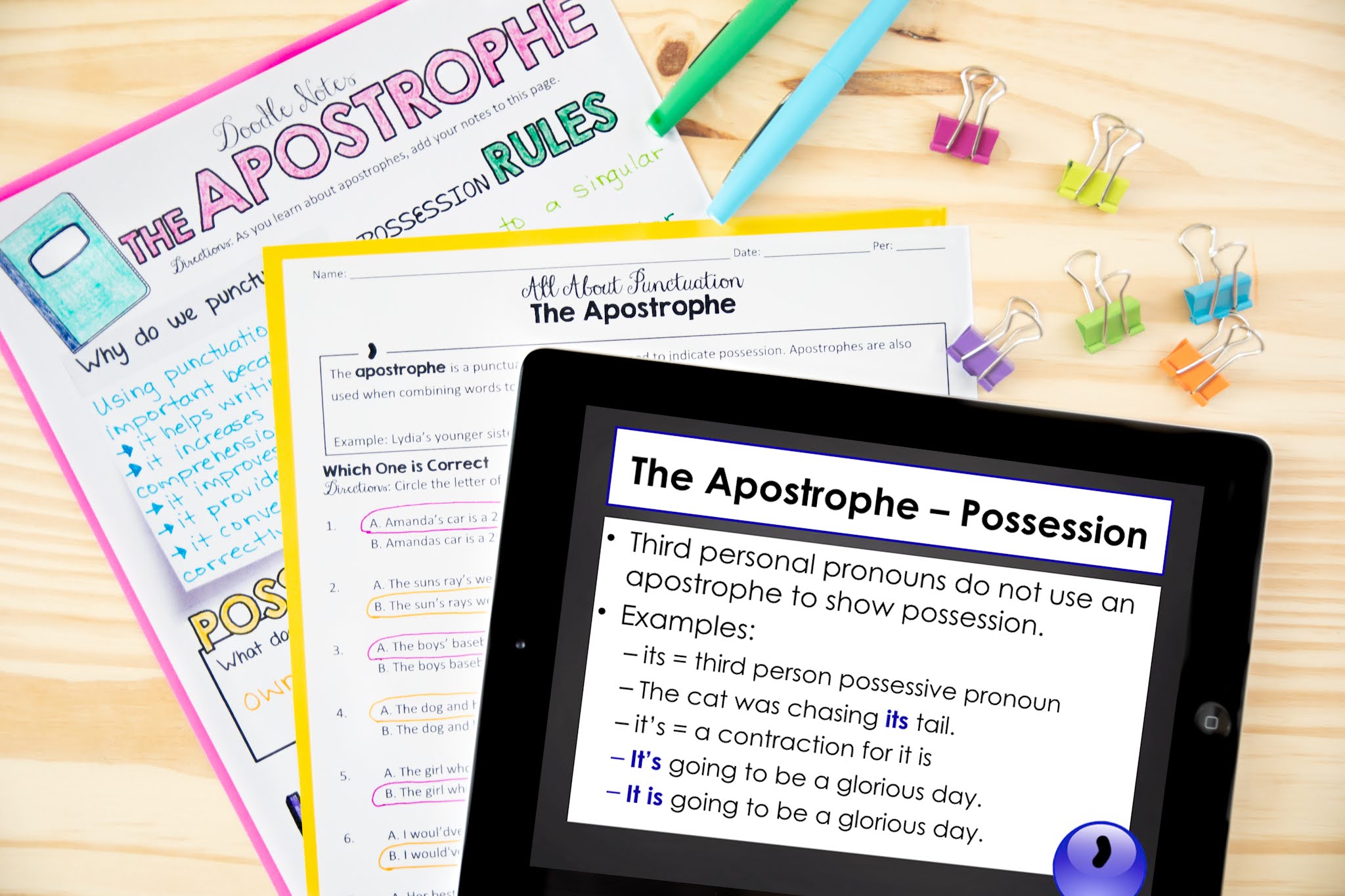One thing many students, teachers, and even professional authors forget is the fact that writing is just a form of communication. Even though students may not see it this way at first, the more we write like we speak, the better our writing becomes. That’s not to say that writing for essays or assignments should be informal; it just means that any writer should utilize grammatical tools in order to achieve a better flow in their work and to guide readers through their thoughts. That’s what punctuation is for! Without it, writing can be confusing or messy. (Let us all remember the “let’s eat Grandma” fiasco.) Who knew a couple of dots and dashes could wreak so much havoc?
When I teach punctuation in my classroom, I use this Punctuation Teaching Unit.
 |
| Punctuation Teaching Unit |
Adjusting Apostrophes
It’s vs. its
It seems a tad ridiculous to make so much fuss over a few three-letter words. However, in this case, one apostrophe quite literally makes all the difference. Contrary to popular belief, “it’s” and “its” are not interchangeable.
It’s – A contraction of the two words “it” and “is”, meaning “it is”. Like other contractions such as “don’t” or “can’t”, “it’s” is two words joined together by an apostrophe.
- Ex. It’s such a shame that it’s raining outside.
Its – A possessive pronoun, like “hers”, “his”, or “theirs”. The aforementioned possessive pronouns do not employ apostrophes because they are all one word.
- Ex. The shelf was lying broken on its side.
Possessive Nouns
Darn that “s”. The pesky letter can get the best of us mixed up, particularly when it’s at the end of words. When dealing with a possessive noun (not be confused with the aforementioned possessive pronoun), the placement of the apostrophe is crucial. For example, if I were to describe some toys that my sister owned, I might write the following:
- Ex. The teddy bears are my sister’s toys.
Simple, right? To show that my sister owns the teddy bear, I add an apostrophe and an “s” to the noun “sister”. However, things get a bit trickier when one is dealing with plural possessive nouns, because those nouns already have an “s” at the end. What if I had multiple sisters? In that case, the apostrophe would come after the “s”. I would write:
- Ex. The teddy bears are my sisters’ toys.
All of the above goes for any person(s), place(s), or thing(s).
Remember: Apostrophes don’t make things plural. They signify ownership or the combination of two words. Don’t add one wherever you see an “s”.
Consider the following sentence: The teddy bear’s are my sister’s toy’s.
S’cary is’n’t it?
Crazy Commas
Any student worth their salt will probably have the answer to the question of why commas are necessary. Their eyes would roll into the back of their head as they droned out, “To prevent a run-on sentence.” So, let’s ask a different question! Where does that oh-so-indispensable comma go?
After an introductory element
Your students are probably well aware of that much-needed transition sentence between the paragraphs of their essays. You know, the ones that begin with fancy words like “nevertheless” and “however” and “therefore”. These words are a great example of the introductory element that a comma should follow!
- Ex. However, the principal had yet to realize that none of us cared about the rules.
Introductory elements can be long or short! They can be one word like the above example, or they can be quite wordy, like the one below!
- Ex. As long as you follow the extremely wordy introductory element at the beginning of your unbelievably brilliant sentence with a comma, you’ll be golden!
FANBOYS
If your students are anything like me, then they’ve probably heard of “FANBOYS”, but have never actually had it explained to them. Be the teacher to clear up the confusion! Or, in the case that they do remember FANBOY’s meaning, be the teacher to really drive it home!
FANBOYS is a mnemonic device that stands for the following words:
For
And
Nor
But
Or
Yet
So
Each of these words functions as a device to connect two independent clauses! So what does this have to do with commas? When one of the FANBOYS is at work, the comma must come before it.
- Ex. I love writing, but I’m beginning to develop a writer’s callus.
The coronavirus is hospitalizing thousands, yet foolhardy individuals continue to jeopardize public health and safety by partying in large groups.
See! It’s easy peasy, so there’s no reason to exclude the comma!
When in doubt, remember this handy question: What’s the difference between a cat and a comma?
Answer: A cat is an animal with claws on the end of its paws, and a comma is a pause at the end of a clause!
Commas are a way of effectively writing in a pause where we would likely place one in our normal speech, anyway!
- Ex. Mom said let’s run over kids!
That’s pretty ominous, huh? Let’s try adding a pause!
- Ex. Mom said let’s run over, kids!
Phew! I wonder where they’re running over to?



